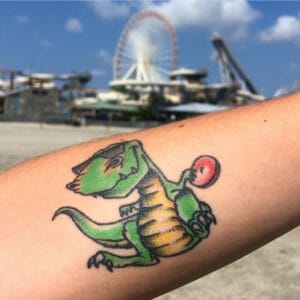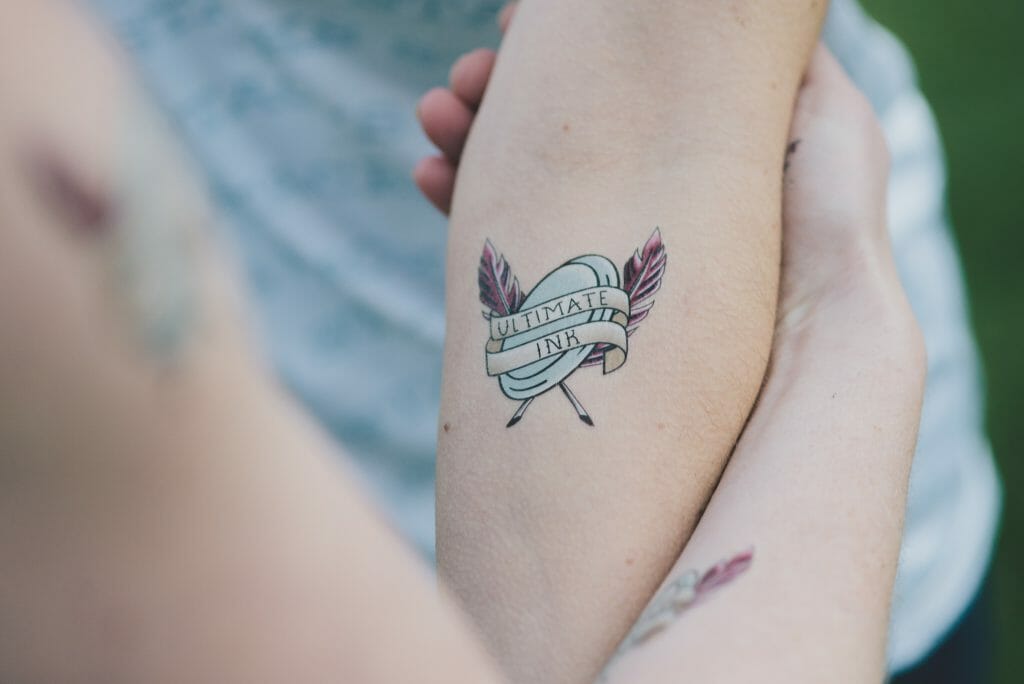Every ultimate tattoo means something.
December 2, 2019 by Guest Author in Other with 0 comments

This article was written by Liz Clark, the creator of Ultimate Ink.
For many people, ultimate defines how we structure our time. It dictates who we spend it with, and the way we think about ourselves on and off the field. It seems to me that many people equate their presence on a team or in a league with their identity in the ultimate community, and that not having a spot on one means losing their place in the other. But a lot of things can happen — physically, emotionally, or logistically — that can change how we play, who we play with, or even if we play at all. How can we reconcile our sense of identity and place in the community when that happens?
This is the story of how I arrived at that point.
It’s funny because I’ve worked with dozens of people to craft and share personal narratives about ultimate, but I’m just now getting up the nerve to share mine. I started playing club when I was 16 years old — I had to miss 2008 Club Regionals because it was the same weekend as the SATs. Earlier that summer, I went to Vancouver with the USA U-19 team. By 18, I had made a Nationals-caliber club team as a practice player and was on track to get on the roster the following year. I felt unstoppable.
Then, things took a turn. In the same year, I got cut from my last chance to make USA U-19 and failed to find a spot on either of the elite-level club teams in my state. After the call from the last team’s captain, I was devastated.
At 19, I felt like my ultimate career had hit a dead end. I was also completely burned out. I had been playing, throwing, or working out for ultimate almost every day for the entirety of my teenage years. Playing competitively had become a major part of my identity, and my feeling of self-worth in the community had become tied to whichever team name happened to be on my jersey. Between then and now, I effectively stopped playing ultimate; without actively working towards the next big thing or a clear path for how to get there, I had no idea where I fit in.
There are a couple things that I’ve come to realize about ultimate that I couldn’t see then. For one thing, there’s a lot to becoming a great competitive player that happens off the field. Learning how to stay level-headed under pressure, acquiring the capacity to handle the ups and downs of the game — these are skills that take time and a certain degree of emotional development to master. Also, and this is the case at any level of the sport, three people in a room making a decision about a roster are not assigning inherent value to a person’s indefinite potential as a player. Most importantly, thanks to some wise words from a few good friends, I’ve realized that there’s a spot for everyone in the ultimate community, including me. This past summer, at 27, I started playing competitively again.
As I’ve been sharing my story, I’ve realized that my feelings of uncertainty about how I fit into the community are not unique. It seems as though many serious ultimate players have something going on beneath the surface. Like when I spoke with a player who’s getting older and worries about a future where they’re not offered a spot on a team that has become an integral part of their lives. Or when a veteran at the elite level shared that they stopped playing because they were exhausted from fighting for their spot in their friend group every time they stepped on the field. Or when someone shared with me that they’re suffering from a mental health condition that’s making 100% attendance at practices, track workouts, and team events impossible, but they’re afraid to share this with their captains and teammates for fear that their commitment level might be called into question.
I think it is important to acknowledge how challenging it can be to have a competitive athletic activity as a central pillar of our personal identities. It is also critical to be able to be honest with ourselves and each other about where we are along our journey, and to reach out for support within the community whenever and wherever we find ourselves unsure of how we fit in. However, the intensity of the sport rarely provides opportunities for us to reflect on and share our experiences with each other. That was my inspiration for starting Ultimate Ink.
 Ultimate Ink is a story-sharing platform that uses ultimate tattoos and tattoo designs as a jumping-off point to share personal narratives about the sport. Along with showcasing the badass body art that ultimate has inspired, I believe that every ultimate player — from summer league rookie to Riot returner — has a story to tell. Through sharing our experiences with each other, we become stronger teammates and a better community. So far, we’ve received over 75 stories from people all over the world.
Ultimate Ink is a story-sharing platform that uses ultimate tattoos and tattoo designs as a jumping-off point to share personal narratives about the sport. Along with showcasing the badass body art that ultimate has inspired, I believe that every ultimate player — from summer league rookie to Riot returner — has a story to tell. Through sharing our experiences with each other, we become stronger teammates and a better community. So far, we’ve received over 75 stories from people all over the world.
Since I started the project, I’ve been blown away by the candidness with which people have shared their experiences. Many stories take on serious subjects with a vulnerability that’s rare to find on social media. One person wrote about their history with substance abuse and how ultimate gave them a second chance. Another person described the adverse circumstances they faced growing up, and how ultimate provided a life-changing opportunity for them to develop their self-confidence. Another reflected on the way that ultimate gave them a space to discover their sexual orientation. People describe everything from meeting their best friends to grappling with mental health, from personal loss to falling in love.
It’s become so clear through this project that a deep personal connection to the sport is pervasive through our community, and each player, whether we know it or not, is bringing unique experiences with them to the field and taking something meaningful home. Whenever I read a new story, I’m reminded of how incredible this community is and I’m filled with gratitude to be a part of it again. I’ll admit that a lot of the stories make me cry.
Something I’ve noticed through this project is that we seem to celebrate our victories together, like when teams get tattoos when they make Nationals, or when cohorts of players get tattoos when they graduate from college. Our personal battles, on the other hand, like injuries, getting cut from a team, moving to a new city, or retiring, we’ve been experiencing alone. I challenge the ultimate community to support each other in our losses the same way we cheer for each other in our successes.
If we work towards being unconditionally supportive of each other, I believe that we can become better teammates and a stronger community on and off the field. All it takes is the courage to share a piece of yourself, whether it be a tattoo, or a story, or any of the laundry list of struggles that we all go through. I will be here to receive you with open arms, and I think we’ll find that our community will do the same.
You can find Ultimate Ink and players’ stories on Instagram.
